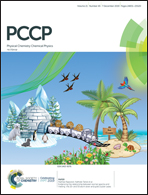A theoretical study of the geometries, and electronic and surface properties of sphere-like (SiB)2n (n = 6–27, 30) functional nanomaterials
Abstract
The geometries and electronic properties of (SiB)2n (n = 6–27, 30) clusters are systematically investigated based on the gradient corrected Perdew–Burke–Ernzerhof exchange–correlation functional. In particular, the (SiB)36 cage is identified as the most stable nanocluster and (SiB)2n (n = 6–27, 30) nanocages prefer to have sphere-like geometries. By increasing the (SiB)2n (n = 6–27, 30) nanocage size, the calculated energy gaps of (SiB)2n (n = 6–27, 30) nanocages generally decrease and absorption wavelengths of the spectra of (SiB)2n (n = 6–27, 30) nanoclusters are elongated. The varied size of the nanoclusters leads to a quantum confinement effect indirectly. Interestingly, the nanosized (SiB)30–60 cages exhibit a stronger capacity for solar energy absorption or conversion due to both narrow HOMO–LUMO energy gaps and a large DOS near LUMO and HOMO levels. Finally, electronic charges transferred from silicon atoms to their surrounding boron atoms in (SiB)2n (n = 6–27, 30) contribute to the metallic characteristic and B–Si ionic bonds, and eventually enhance the stabilities of the nanocages.



 Please wait while we load your content...
Please wait while we load your content...